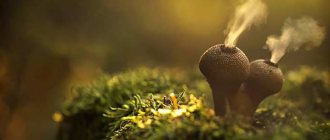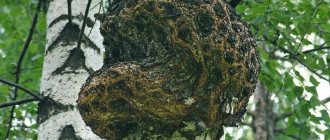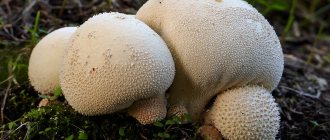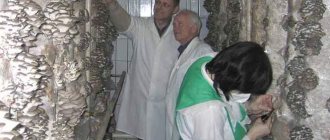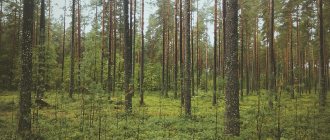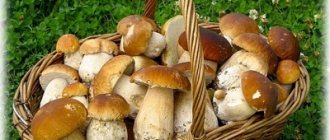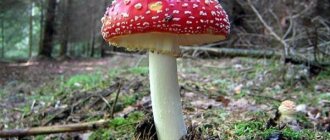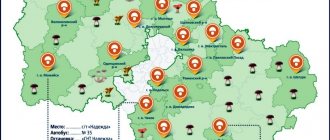The aroma of fried mushrooms always makes you hungry. Even if there were ordinary russula in the frying pan. Mushrooms are a tasty, gastronomically valuable product that also has pronounced nutritional properties. None of the types of mushrooms cause obesity, but any of them saturates the body with vegetable proteins, fiber, vitamins, and minerals. The property of mushrooms to remove toxins from the body is also known - but this is only relevant for those fruiting bodies that grew in an ecologically clean area.
Each type of mushroom has its own specific taste and aroma. Some of them turn out to be so tasty that they are included in the list of delicacies and are highly valued throughout the world. In the opinion of the European consumer, small autumn honey mushrooms, the caps of which have not yet reached one centimeter in diameter, are of great value.
Chanterelles are also highly valued - not only for their delicate taste, but also for their ability to cleanse the body of radiation and provide cancer prevention. Ryzhiki are another gastronomically valuable type of mushroom, because their taste and aroma are truly unique, and their appearance after frying stimulates the appetite. But this is not a complete list of delicious mushrooms, because there are even more valuable types.
Honey fungus
This name hides a whole group of mushrooms belonging to various families and genera, which received their name because of the place where they grow: on stumps or dying trees. Some varieties continue to grow even in winter, emerging from under the snow during thaws.
Due to the fact that most of the species of these mushrooms are considered conditionally edible, they are practically not consumed in Western Europe. In our country, autumn honey mushrooms are quite popular and are used for pickling and pickling. Their price is quite reasonable: about 100 – 300 rubles per kilogram.
Important: These mushrooms must be eaten after careful heat treatment! If undercooked, they can trigger the development of allergies and eating disorders!
Fifth place - milk mushrooms
White milk mushrooms
Salted milk mushrooms are one of the most desirable dishes on the winter table. White milk mushrooms are especially highly valued. They have a specific forest aroma, which is why experienced chefs do not add many spices when pickling, and sometimes even exclude them altogether, leaving only oak, cherry or bird cherry leaves. Salted milk mushrooms have a pleasant crunch and can be used as an independent snack or as a component of one of many dishes. Having 16 Kcal per 100 g of product, they contain a minimum of fat and carbohydrates, but are rich in protein. They are recommended for urolithiasis and tuberculosis. They are also rich in B vitamins and vitamin C.
Interesting: The most edible mushrooms - list, names, descriptions, photos and videos
Chanterelles
Or Cantharellus cibarius belongs to the genus Cantarelaceae. Unlike many other mushrooms, it is practically not damaged by pests. You can recognize a fox by the following signs:
| The size and shape of the hat | 2.5-5.0 cm, with a depression in the central part with asymmetrical convexities at the edges. |
| Leg type | Shortened, up to 4 cm in length, with a smooth texture. |
| Availability of records | Bright yellow hue. |
Its pulp is dense, elastic, white or yellowish in color, has a rich aroma and excellent taste. Valued for its content of carotene and other valuable elements. It is not recommended for people with diseases of the gastrointestinal tract, as it is difficult to digest. It is fried, stewed, and used as a side dish for dishes. Price: from 250 to 300 rubles per kilogram.
Boletus
A representative of the Obabok genus, common in coniferous and mixed forests of Europe and North America. You can find this cute mushroom with a strong stem and a reddish-orange cap under spreading, large trees, on moist, mossy soil.
Its characteristic feature is a change in color of the pulp upon contact with oxygen, which turns from whitish or yellowish to bluish when cut. Boletuses are valued for their excellent taste and characteristic “mushroom” aroma, which adds piquancy to various dishes. Their pulp has a pleasant juiciness and a dense structure. They are used for food in fresh or dried form. The price of such a mushroom: from 400 to 700 rubles per kilogram.
Third place - flywheel
Mokhovik mushroom
Mokhovik is another mushroom with exceptionally tender flesh, a delicate forest aroma that does not tolerate the addition of a large amount of spices. Suitable for cooking and frying. It has a fleshy cap and a thin stalk. The calorie content is about 20 Kcal, the product is rich in protein and contains a minimum of carbohydrates. Not too common, but tends to grow in groups. To get a vivid gastronomic experience, you just need to fry a few of these mushrooms with the addition of salt and butter - without any other ingredients.
boletus
The habitats of this representative of the mushroom kingdom are light birch groves and deciduous forests. Another name for this mushroom is Léccinum scábrum.
Its distinctive features:
- The cap is whitish-brown or gray-black, resembling a cap.
- Club-shaped, slender leg with grayish scales.
- Dense white pulp with excellent taste.
This species includes about ten different varieties, including marsh, gray, common, black or checkerboard boletus. All of them are edible. These mushrooms are especially tasty when fried. They cost about 250-700 rubles per kilogram.
Interesting: in terms of protein content and other valuable microelements, boletus mushrooms are comparable to meat. They contain potassium, calcium, manganese, vitamins C, B1, B2, PP and E.
Porcini
Many are accustomed to calling this mushroom boletus. It is very popular in Russia. It can be recognized by its convex red-brown or light-colored cap measuring 7-30 cm, a massive, voluminous leg and juicy, fleshy, light-colored flesh that does not change color after being cut. Habitat: coniferous, deciduous forests. Usually this mushroom is found under old spruce, birch, pine or oak trees.
It belongs to the noble representatives of the family and is actively used in cooking in fresh and dried form due to its rich, expressive taste. Helps stimulate digestion, protects against the development of tumors. The cost of a mushroom, depending on the shape of the preparation, ranges from 600 to 3,000 rubles.
Cooking process
Cooking time depends on the characteristics of the dish and the option of further heat treatment:
- Frying. Before frying and stewing, honey mushrooms are boiled for at least an hour. First they boil for 20 minutes, then salt, spices, and chopped onions are added to them. Then cooking lasts 40 minutes. The cooked product is taken out and dried. You can fry it with any food.
- Freezing. Large mushrooms take longer to cook than small ones. Maximum time – 1 hour. After the first 20 minutes of cooking, drain the water and add fresh boiling water.
- Pickling. You need to cook the product for 60-80 minutes until completely cooked. After the first 20-25 minutes, the water is drained and new salted and seasoned water is added. The process starts again.
Dried mushrooms are boiled for about half an hour until their shape is completely restored.
The article was prepared by our author Roman. He will be interested in knowing your opinion regarding the usefulness of the information provided. Please leave a few comments or suggestions on the article, and share what else you would like to know.
Shiitake (Lentinula edodes)
This mushroom is also called Lentinula edible or Japanese forest mushroom. Habitat: semi-decomposed wood of deciduous trees. Its caps are used for food, mainly after drying. This mushroom is more popular in Asian countries.
Their medicinal properties have been known since ancient times. Shiitake mushrooms have been used to treat various diseases since the Ming Dynasty. Currently, it is also used to lower blood cholesterol levels, treat obesity or impotence in men. The average price of such mushrooms in dry form is about 1,700 rubles per kilogram.
Features of growth
The Truffle mushroom grows underground, as evidenced by its detailed description and photo. It is always located at the roots of the tree. Without them, truffles have nowhere to get nutrients.
But if you wish, you can grow such mushrooms even at home. For this, hazel or oak seedlings are used. The seedlings are left in sterile conditions for several weeks. This is required for the mycelium to take root. Only then are the resulting seedlings planted in the nursery. This can be done in the spring.
First, a small amount of water is poured into the hole. And only then it is densely covered with fathoms of soil and watered again. Near each of them a layer of forest soil with leaves and a film must be laid.
Reishi (Ganoderma, Mannentake)
In China it is called the “mushroom of immortality” or “ling zhi”, and in the Land of the Rising Sun, Japan, it is called the “mushroom of spiritual power”, “reishi”. Its scientific name is lacquered tinder fungus.
Appears at the base of sick or dying trees. It has a flat, ridged cap of a brownish-violet or red hue. It is highly valued for its medicinal properties. Used in the treatment of viral and oncological diseases, helps improve immunity. The price for this mushroom starts from 2,000 rubles.
Morel (Morchella)
Appears in early spring, after the snow melts. It's not easy to find. The most common habitats: wet ravines, deciduous forests, and other places with soil rich in nutrition. It should not be confused with another early mushroom, the string, which is considered conditionally edible.
In Russia, this amazing mushroom, shaped like a shriveled brain or a sponge, is practically not eaten, but in European countries it is considered a delicacy and costs about $560 per kilogram. When drying, this price can increase many times.
What are the benefits of truffles?
Truffles
rich in vitamins PP, B1, B2, C. This mushroom is useful during periods of rapid growth: childhood and adolescence, pregnancy and lactation.
In addition, truffle
is an antioxidant.
An Italian cosmetics concern makes cosmetics from truffles
.
Interesting materials:
What should the air temperature be with optimal microclimate parameters in workplaces during the warm season? What year is 1977 which animal? What year is 2010? What year is 21? What year will 2022 be? Which year will be the Year of the Horse? What year is it to be 18 years old? What year is retirement in 2022? What year is retirement in 2022? What year is the car?
Matsutake (Tricholoma matsutake)
A very expensive mushroom, valued for its unusual taste and aroma, reminiscent of pine, for which in Asia it is sometimes called “pine mushroom.” It has an umbrella-shaped brown cap, white, elastic flesh with a spicy cinnamon aroma. It grows on poor, infertile soils, under the cover of dense trees (fir, pine).
Despite the abundant fruiting, it is very difficult to find it, since it is practically invisible under the fallen leaves. Because of this, the price of this unique natural product is quite high: about 2,000 US dollars per kilogram fresh.
Chinese Cordyceps (Ophiocordyceps sinensis)
The most expensive mushroom at the moment is considered to be Yarsagumba, otherwise called Chinese Cordyceps, per kilogram of which in Asian markets you can “earn” from 50,000 to 120,000 dollars. Such a high cost of the mushroom is not accidental, given that it grows in Tibet, at an altitude of more than 4,000 meters.
By its nature, it is a parasite that lives in the caterpillars of the butterfly species Hepialus armoricanus. As it develops, it feeds on the flesh of its “host,” growing through the body of the caterpillar after its death. These mushrooms are collected by hand.
The mushroom is considered a powerful aphrodisiac, has healing powers and a tonic effect on the body. According to Tibetan healers, yarsagumba is effective in the fight against cancer and leprosy, and completely cures tuberculosis. But only very rich people can afford such a luxury, since the cost of one tiny mushroom is about $500.
The uniqueness of the listed mushrooms lies in their rarity, excellent taste and unusualness, for which true gourmets are willing to pay huge amounts of money. And, given that the number of these and other mushrooms in the wild is gradually decreasing, the value of these “natural delicacies” is only increasing.
